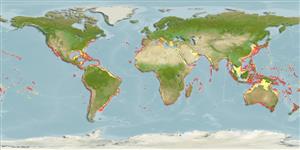Classificação / Names
Common names from other countries
Referência principal
Tamanho / Peso / Idade
Max length : 400 cm TL macho/indeterminado; (Ref. 89972); common length : 270 cm TL macho/indeterminado; (Ref. 9253); Peso máx. publicado: 167.4 kg (Ref. 40637); Idade máx. registada: 22 anos (Ref. 31395)
Length at first maturity
Lm ?, range 180 - 200 cm
Ambiente
; marinhas; oceanódromo (Ref. 51243); intervalo de profundidade 0 - 230 m (Ref. 58302), usually 0 - 152 m (Ref. 55185)
Clima / Intervalo
Subtropical; 18°C - 28°C (Ref. 244), preferred 28°C (Ref. 107945); 46°N - 43°S, 180°W - 180°E (Ref. 6871)
Distribuição
Cosmopolitan (Ref. 26340). Western Atlantic: Maine, USA to Argentina; also in Gulf of Mexico and Caribbean (Ref. 26938). Eastern Atlantic: Portugal to Gulf of Guinea; possibly occurring in the Mediterranean. Indo-Pacific: Red Sea and East Africa to the Hawaiian, Samoan, Tahiti and Tuamoto islands. Eastern Pacific: southern California, USA to Peru, including the Galapagos. Highly migratory species, Annex I of the 1982 Convention on the Law of the Sea (Ref. 26139).
Países | Áreas FAO | Ecossistemas | Ocorrências | Introduções
Descrição breve
Espinhos dorsais (total): 0; Raios dorsais moles (total): 0; Espinhos anais 0; Raios anais moles: 0. A stocky shark with a huge, rounded 1st dorsal fin, and long, wide-tipped pectoral fins; snout bluntly rounded; upper teeth triangular; interdorsal ridge present (Ref. 5578). Back usually dark grey with a bronze tinge, sometimes brown or bluish; belly whitish, sometimes with a yellow tinge; tips off first dorsal, pectorals, and lower lobe of caudal often white or with white spots (sometimes absent); ventral surface of pelvic fins, apices of anal and second dorsal, and ventral lobe of caudal often with black spots; black or dusky saddle-marks in front of second dorsal, upper margin of caudal and between dorsal fins (especially in young) (Ref. 9997).
Categoria na Lista Vermelha da IUCN (Ref. 115185)
Utilização humana
Pescarias: espécies comerciais; peixe desportivo: sim
Ferramentas
Relatórios especiais
Descarregue XML
Fontes da internet
Estimates of some properties based on models
Phylogenetic diversity index
PD50 = 0.5000 many relatives (e.g. carps) 0.5 - 2.0 few relatives (e.g. lungfishes)
Nível Trófico
4.2 ±0.4 se; Based on diet studies.
Resiliência
Muito baixo, tempo mínimo de duplicação da população maior que 14 anos (K=0.1(?); tm=5; tmax=22; Fec=1)
Vulnerabilidade
High to very high vulnerability (75 of 100)
Categoria de preço
